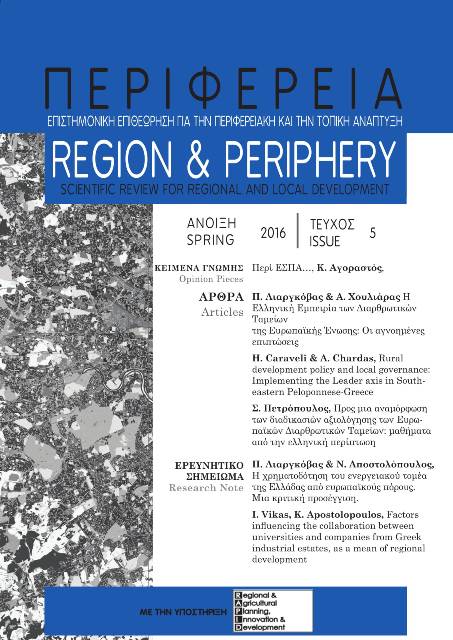Παράγοντες ενίσχυσης της συνεργασίας μεταξύ των πανεπιστημίων και των επιχειρήσεων των Βιομηχανικών Περιοχών της Ελλάδας , ως μέσο προώθησης της περιφερειακής ανάπτυξης

Περίληψη
Οι Βιομηχανικές Περιοχές της Ελλάδας και οι επιχειρήσεις που τις αποτελούν δημιουργούν πόλους περιφερειακής ανάπτυξης και τοπικά κέντρα καινοτομίας. Η ανάπτυξη της συνεργασίας μεταξύ των πανεπιστημίων και των τοπικών επιχειρηματικών κέντρων μπορεί να ωφελήσει σημαντικά την τοπική οικονομία και κοινωνία. Η παρούσα πρωτογενής έρευνα, επεκτείνεται σε 100 επιχειρήσεις από συνολικά 19 Βιομηχανικές Περιοχές της χώρας και αναδεικνύει ορισμένους σημαντικούς παράγοντες ενίσχυσης της συνεργασίας των πανεπιστημίων και των επιχειρήσεων. Η έρευνα διενεργήθηκε το 2013 μέσω δομημένου ερωτηματολογίου και αντλήθηκαν συγκεκριμένες μεταβλητές για τη δημιουργία ενός μοντέλου πολλαπλής γραμμικής παλινδρόμησης. Από τα αποτελέσματα φαίνεται ότι ο βαθμός ανάπτυξης συνεργασίας μεταξύ επιχείρησης και πανεπιστημίου επηρεάζεται θετικά από τον αριθμό των εργαζομένων της επιχείρησης και τον βαθμό ανάπτυξης συνεργασίας μεταξύ της επιχείρησης και οργανισμών της τοπικής αυτοδιοίκησης. Αντιθέτως επηρεάζεται αρνητικά από την έλλειψη πληροφόρησης και από το μέγεθος της Βιομηχανικής Περιοχής στην οποία είναι εγκατεστημένη η επιχείρηση.
Λεπτομέρειες άρθρου
- Πώς να δημιουργήσετε Αναφορές
-
Βήκας Ι., & Αποστολόπουλος Κ. (2018). Παράγοντες ενίσχυσης της συνεργασίας μεταξύ των πανεπιστημίων και των επιχειρήσεων των Βιομηχανικών Περιοχών της Ελλάδας , ως μέσο προώθησης της περιφερειακής ανάπτυξης. Περιφέρεια | Regional Integration: Politics, Economics, Governance, (5), 89–100. https://doi.org/10.12681/rp.18490
- Ενότητα
- Ερευνητικό Σημείωμα

Αυτή η εργασία είναι αδειοδοτημένη υπό το CC Αναφορά Δημιουργού – Μη Εμπορική Χρήση 4.0.
Οι συγγραφείς των άρθρων που δημοσιεύονται στο περιοδικό διατηρούν τα δικαιώματα πνευματικής ιδιοκτησίας επί των άρθρων τους, δίνοντας στο περιοδικό το δικαίωμα της πρώτης δημοσίευσης.
Άρθρα που δημοσιεύονται στο περιοδικό διατίθενται με άδεια Creative Commons 4.0 Non Commercial και σύμφωνα με την άδεια μπορούν να χρησιμοποιούνται ελεύθερα, με αναφορά στο/στη συγγραφέα και στην πρώτη δημοσίευση για μη κερδοσκοπικούς σκοπούς.
Οι συγγραφείς μπορούν να καταθέσουν το άρθρο σε ιδρυματικό ή άλλο αποθετήριο ή/και να το δημοσιεύσουν σε άλλη έκδοση, με υποχρεωτική την αναφορά πρώτης δημοσίευσης στο περιοδικό Περιφέρεια.
Οι συγγραφείς ενθαρρύνονται να καταθέσουν σε αποθετήριο ή να δημοσιεύσουν την εργασία τους στο διαδίκτυο πριν ή κατά τη διαδικασία υποβολής και αξιολόγησής της.


